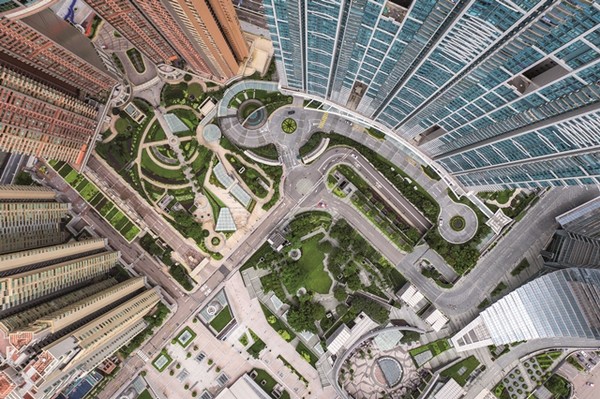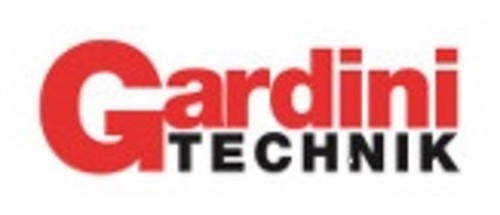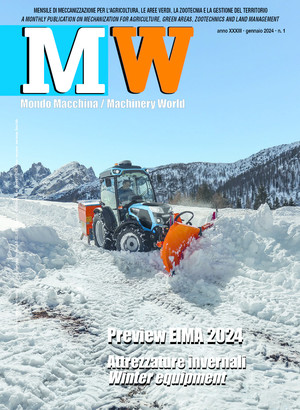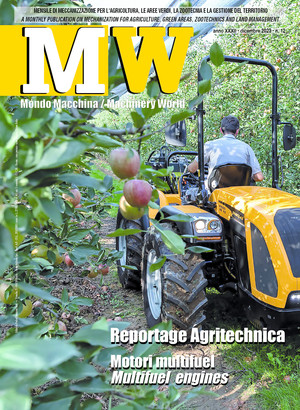
Alternative weeding solutions for urban green
The care of green areas in cities and metropolises takes on an increasingly strategic value given that an increasing share of the planet’s population lives in urban settings, where health and quality of life depend very much on the availability of well-kept and equipped gardens and green spaces. Some techniques that are fundamental in agricultural activity also become of primary importance in the care of green areas, one of which is weeding, currently possible with mechanical and thermal methods, as well as biocontrol systems
In 1950, the world population was around 3 billion inhabitants, 70% of which lived in rural areas and 30% in urban areas; in 2050, it is estimated that the world population will reach 9 billion, of which 70% in urban areas and 30% in rural areas. The population is growing fast and is increasingly urbanized, especially in Africa and Asia, where today there are already cities such as Mumbai with 18.5 million inhabitants and New Delhi with 16.5 million inhabitants. Increasingly populated cities, congested with traffic, and high pollution rates. In addition to this, there are the problems linked to climate change and the extreme weather events and conditions that also affect urban areas.
To improve the quality of life in the city, measures are taken to try and reduce emissions of CO2 and other greenhouse gases, intervening on energy consumption, urban transport, urban mobility, housing construction etc.. Furthermore, urban green ecosystem services must increasingly be considered. After all, on the topic of climate change and loss of biodiversity, the UN calls for the promotion of policies aimed at making our planet greener, by safeguarding and substantially increasing green areas.
We should also keep in mind that working in the city obliges us to work in closed and often confined spaces, with artificial light and without any contact with nature. It’s no coincidence that we speak of “indoor generation”. This generates in the population a need for green areas, considered as places not only of wellness and leisure, but also of socialization.
Having green areas in the city is therefore fundamental for improving the environment, the climate, and the living conditions of its inhabitants. However, it is also necessary to implement maintenance that is correct and sustainable in the environmental aspect of public green areas, so as to make it fully usable by the population. Precisely for this reason, increasingly restrictive regulations have been adopted for the use of synthetic pesticides in the defence against plant pests and to combat weeds.
Fight against weeds
The fight against unwanted weeds along the paths that cross public green areas, be they parks, gardens, monumental areas, etc. and, more generally in the urban context, implemented as an alternative to treatments with synthetic chemicals, can be performed in various ways. These solutions have their validity, but the final choice must be adequately weighted in relation to the conditions in which one operates. We will present some of them.
Grassing
The use of grassing in areas of transit, as an alternative to weeding, is based on the consideration that cutting grass is more economical and ecological than using synthetic herbicides. Grassing compact soils with poor organic matter and fertilizing elements requires adequate soil preparation and the use of a specific seeding mixture.
The preparation of the soil should be limited to mechanically breaking the crust to a few centimetres deep. The soil should not be over-refined and any coarse elements should be removed manually. The choice of the composition of the mixture of seeds to be used is related to the type of soil, the climate, and the site usage. General requirements are: quick installation, slow growth, trampling resistance, and tolerance to short cutting. For this reason, grasses (some varieties of fescue and poa) are preferred, with the addition of mycorrhizae. Sowing takes place in autumn or early spring, when the water content in the soil is higher. Sowing density is related to the type of mixture. It ranges from 10 to 35 g/m2. Also the frequency of grass mowing depends on the type of mixture and climatic conditions, with values ranging from 2 to 6 interventions per year.
Mechanical method
Elimination weeds on hard surfaces, on sidewalks, at the base of walls, on the edges of paths, etc., can be done mechanically by brushing machines. The work is carried out by brushes rotating at a speed of 100 - 200 rpm which, in addition to eradicating the weeds, also perform surface cleaning. The brushes are made up of disks into which some fibres are inserted; the minimum working width is about 50 cm. Three types of brushes are used: those with propylene fibres, those with fibres consisting of flexible steel strips, and the mixed ones, that is with propylene fibres and steel fibres. This affects the quality of work and the type of intervention. Obviously the thinner and more flexible the fibres, the higher the density of the brush, so the more thorough the cleaning work, though less energetic. The choice depends on the surface to be treated and the weeds’ development. Brushes with mixed fibres do not exert an abrasive action on the ground and are recommended for interventions on weeds at their initial stage (seedlings). When the weed is well rooted, an energetic intervention is needed, so that the brushes with metallic fibres work better. Brushes with propylene or nylon fibres are suitable for rough surfaces, but their action is rather superficial. The durability of the fibres varies depending on the frequency of interventions and the type of soil. On average, it is around 100 hours, after which they must be replaced. These brushes are generally mounted on tool carriers with a driver on board and also with a driver on the ground. To eradicate weeds along canals and at the foot of sidewalks and walls, machines are built with a side protection that avoids spreading weeds on the road. After the brushing machine has passed, the removed weeds are collected in swaths behind the machine. A subsequent collection step is therefore necessary. The number of steps to obtain a satisfactory result varies depending on the conditions. On average, there are 3 to 7 steps to get a good result. One of the advantages is that the operator immediately understands the effectiveness of the intervention. A particular mechanical weeding solution is the manual brush cutters on which a specific cutting head is mounted with counter-rotating blades, in order to avoid projecting the cut grass and any stones or other material that may be on the ground. This equipment is suitable for finishing work on the edges of paths and pavements, and also for interventions around trees and bushes without the risk of producing abrasions on the bark.
Thermal methods
The thermal methods are mainly used on paved surfaces, on paving stones or on concrete. The systems can be: with hot water, with hot water and biodegradable foam, with steam, with hot air, with direct flame or with infrared rays. For all these systems, it is fundamental to intervene at the initial stage of the infesting vegetation, i.e. to act at the stage between zero and four leaves (February-March). One should also consider that with the thermal intervention, besides eliminating weeds, we also combat their seeds and any spores present in the soil. Despite the safety of using these means, in some cases there is still a certain reluctance due to the fact that fossil energy is used, and there are fears of risks for the environment and the operators. Weeding with hot water consists in spraying boiling water at 95-150°C and injecting it at low pressure directly onto the weeds. This treatment causes the cellular rupture of the seedling tissues and at the level of the root collar, also acting on the weed seeds on the surface. The result is seen after a few days. The treatment must then be repeated to hit the inevitable sprouts. The number of passes varies from 3 to 5, depending on the conditions. The essential component of the machine is the boiler generally fuelled by diesel oil, but also with batteries, which heats the water quickly. Depending on the model, the water tanks have different capacities. The distribution is made by a nozzle-holder bar or by lances carried by hand. The boiler is mounted on a tool holder or on a trailer. In smaller models, the boiler is mounted on self-propelled wheelbarrows also powered by batteries. In the most advanced machines, a system of sensors placed on the distributing bar recognizes the presence of weeds, thus adjusting the spraying. The effect of pulverized hot water can be increased by combining it with biodegradable foam. In this way, a more persistent thermal cover is created, which increases the effectiveness of the treatment, avoiding the germination of weed seeds present in the soil. It is a solution especially intended for hard and waterproof surfaces. In machines for steam weeding, a generator turns water into steam at 150°C in less than 1 minute. With this treatment, the rupture of the cell walls is immediate. Just like with hot water, it is necessary to repeat the operation to hit any sprouts. On average, 3 passes are made, even if there are those who believe that 5 to 6 repetitions may be needed. The treatment with hot air under pressure is normally followed with a thermal lance (2 kg) carried by the operator as a backpack so that he can operate with one hand on a 180° wide surface. The lance is connected with the gas cylinder mounted on a wheelbarrow or other some other vehicle. The heat stroke on the leaf surface causes the withering of the weed which, thanks to the reserves contained in the stem, will resume vegetating, so it will be necessary to repeat the intervention several times. The direct flame treatment is performed with machines equipped with a burner apparatus or with piezoelectric ignition lances powered by gas. A flame is generated (between 300 and 1200°C depending on the machine) which, applied for a few seconds near the plant, causes it to dry within a few hours. 4 to 6 passes are required. Also with infrared technology weeds are eliminated with heat, but without any direct flame. The ceramic combustion elements produce a temperature above 1000°C. The infrared rays that are generated cause the death of tissue cells, spores found in the air, and weed seeds up to 1 - 2 mm deep in the soil.
Biocontrol products
Biocontrol products are natural substances that have herbicidal properties. The most active ingredients in these herbicides are pelargonic acid and acetic acid. Pelargonic acid is found in Pelargonium, but also in other plants such as sunflower, rapeseed and rose. Acetic acid comes from the fermentation of sugar. These products have the advantage that they can be used with the same equipment as synthetic pesticides.








